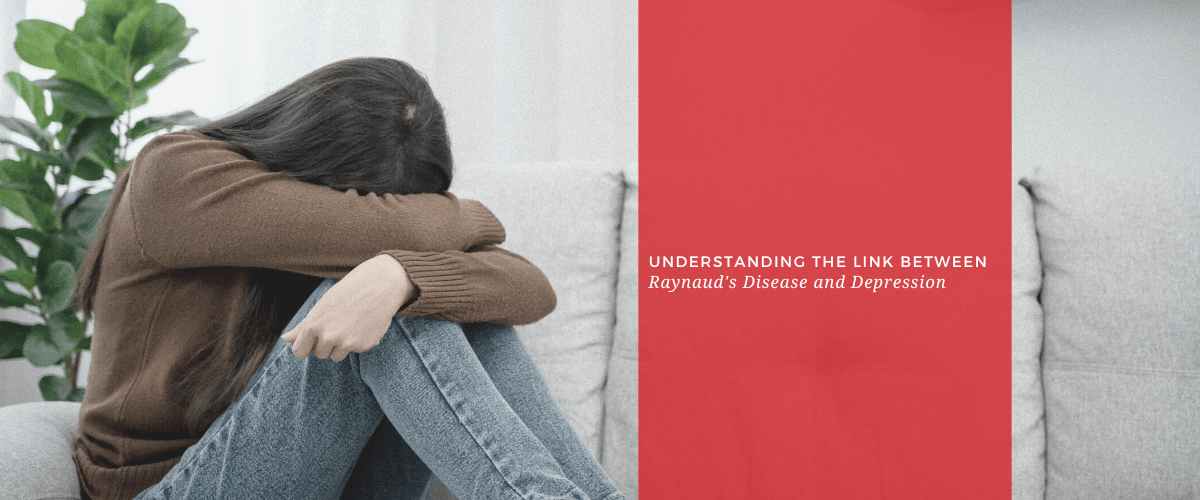With over 1 million orders

Understanding the Link Between Raynaud's Disease and Depression
Let's shed light on the often-ignored mental health implications of Raynaud's disease. With a focus on the established but frequently overlooked connection between Raynaud's disease and depression, the piece offers a comprehensive look at the challenges faced by sufferers, emphasizing the necessity for a holistic approach to treatment that addresses both the physical and psychological facets of the condition.
Despite the drastic impact that Raynaud’s phenomenon can have on an individual’s quality of life, the detrimental effects that the condition may have on mental health are often overlooked. Unfortunately, however, there is a link between Raynaud’s disease and depression, and you can learn more about it in this post.

What is Raynaud’s Disease?
Raynaud's phenomenon is characterized by recurring episodes of blood vessel constriction in the fingers and toes, sometimes affecting other areas, typically triggered by cold or stress. This condition leads to changes in skin color to white, blue, and red, and is often accompanied by pain, numbness, and swelling.

Raynaud's is categorized into two types:
- Primary Raynaud's Phenomenon (PRP), which occurs without associated medical conditions.
- Secondary Raynaud's Phenomenon (SRP), which is linked with other connective tissue diseases and rheumatologic disorders. SRP is more severe, often leading to chronic complications like ulcers and tissue damage.
Management of Raynaud's usually involves pharmacological treatments and preventive measures. However, these treatments might not fully address the overall impact of the condition. There are potential psychological effects, such as depression and anxiety, that can significantly lower the quality of life for those with Raynaud's. Therefore, treatment plans should also consider mental health support to provide a more holistic approach to care.
Psychological Effect of Raynaud’s Disease

The psychological impact of Raynaud's disease, marked by sudden and painful episodes in the fingers and toes, can significantly affect a patient's mental health. This unpredictability leads to increased anxiety, as patients often worry about when and where their next episode might occur. The pain and discomfort associated with these episodes can also cause frustration and distress.
Furthermore, the physical symptoms of Raynaud's, such as the discoloration of extremities, might lead to embarrassment and social discomfort, potentially resulting in withdrawal from social activities. This can exacerbate feelings of isolation, contributing to depressive symptoms.
The 2019 study by Doe & Ray delves into these psychological effects, highlighting how Raynaud's disease can impact the quality of life beyond its physical symptoms stating that: “Anxiety, depression and quality of life impairments should be taken into account when managing all patients with Raynaud’s Phenomenon.”
Managing Raynaud’s Disease and Depression

Dr. Arthritis strongly encourages anyone who is living with either primary or secondary Raynaud's and struggling with their mental health to not suffer in silence. It's important to reach out for help, whether it be to a healthcare professional, a mental health specialist, or a support group.
Recognizing that physical health conditions can have a profound impact on one's emotional well-being is the first step toward holistic treatment. Proactive communication with your doctor about any psychological symptoms is critical, as they can offer or refer you to appropriate psychological support services.
Bear in mind as well that treatment and management strategies for Raynaud's disease involve a comprehensive approach that includes medical interventions, psychological support, and holistic methods to address both the physical and psychological aspects of the condition.
Here are some that you can try:
Medical Interventions
- Vasodilators: These medications help improve blood flow to the affected areas. They work by relaxing and expanding the blood vessels, thereby reducing the severity and frequency of Raynaud's episodes. Patients need to discuss with their healthcare providers to find the most suitable vasodilator, as options vary in effectiveness and side effects.
- Lifestyle Modifications: Simple changes in daily life can significantly impact the management of Raynaud's disease. Avoiding exposure to cold, wearing warm gloves and socks, and managing stress levels can help reduce the frequency of episodes. In addition, patients are advised to quit smoking, as nicotine can constrict blood vessels, and to limit caffeine intake, which may exacerbate symptoms.
Psychological Support
- Cognitive-Behavioral Therapy (CBT): CBT is effective in managing depressive symptoms that may arise due to the chronic nature of Raynaud's disease. This therapy helps patients identify and change negative thought patterns and behaviors, enabling them to better cope with the condition.
- Support Groups: Joining a support group can provide emotional support and practical coping strategies. Sharing experiences with others who understand the condition can reduce feelings of isolation and provide a sense of community.
Holistic Approaches
- Mindfulness-Based Stress Reduction (MBSR): MBSR can be particularly beneficial for patients with Raynaud's disease. This practice involves mindfulness meditation and relaxation techniques, which have been shown to decrease anxiety and depressive symptoms, especially in those dealing with chronic illnesses.
- Regular Exercise: Regular physical activity is recommended for overall wellness. The American Heart Association advocates for exercise as a means to improve cardiovascular health, which can indirectly benefit those with Raynaud's by enhancing blood circulation. Activities like walking, yoga, or swimming in warm water can be particularly beneficial.
The Link Between Raynaud's Disease and Depression
Acknowledging the psychological toll and integrating mental health strategies into the treatment plan is critical for patients' overall well-being. By incorporating medical, psychological, and holistic practices, individuals with Raynaud's can achieve a better quality of life and find greater success in managing both the physiological and emotional challenges of the disease. Whether through medical intervention, lifestyle adjustments, community support, or personal mindfulness practices, each step taken is a move toward holistic health and well-being. Patients and healthcare providers must work together to ensure that every aspect of Raynaud's, both seen and unseen, is addressed with compassion and thoroughness.
Learn more about Raynaud's Phenomenon and your treatment options by checking out our other articles below:
Best Socks for Raynaud's: How Dr. Arthritis Delivers Comfort and Relief
Choosing the Best Gloves for Raynaud's Syndrome
Identifying the Right Specialist: What Doctor Treats Raynaud's Disease?
